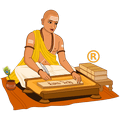
























The ritual of first seating of child on the ground is known as Bhumi Upaveshana and it is an important Sanskara in Hinduism. The time when child is first seated on the earth is considered very significant for the physical growth and well-being of the child. Usually, it is performed in the 5th month after birth.

Notes: All timings are represented in 24-hour notation in local time of Pachora, India with DST adjustment (if applicable).
Hours which are past midnight are suffixed with next day date. In Panchang day starts and ends with sunrise.
All time intervals are categorized into three
Following considerations should be looked into while choosing an auspicious time for Bhumi Upaveshana.
Nakshatra: All fixed Nakshatra i.e. Rohini (4), Uttara Phalguni (12), Uttara Ashadha (21), Uttara Bhadrapada (26), gentle and friendly Nakshatra Mrigashira (5), Anuradha (17) and all short Nakshatra i.e. Ashwini (1), Pushya (8), Hasta (13) and Jyeshtha (18) are considered auspicious for Bhumi Upaveshana.
Tithi: All Tithi except Rikta Tithi are considered good for Bhumi Upaveshana. In other words all Tithi except Chaturthi (4), Navami (9) and Chaturdashi (14) of both Shukla and Krishna Paksha should be discarded.
Days: Except Sunday, Tuesday and Saturday, all other weekdays are considered good for Bhumi Upaveshana.
Lagna: All fixed Lagna i.e. Vrishabha (2), Simha (5), Vrishchika (8) and Kumbha (11) are considered auspicious for Bhumi Upaveshana.
Kundali: Mangala should not be afflicted and should be strong at the time of Bhumi Upaveshana.
Kati Sutra Dharana i.e. wearing of cotton thread around the waist is performed after worshipping the Mother Earth and Lord Varaha (an incarnation of Lord Vishnu) and the child is seated on the ground.
Aajeevika Pariksha is also performed during Bhumi Upaveshana. During it, a number of articles like gold, silver, cloths, knife, books, tools, pen, toys, etc. are put in front of the child and whatever article the child picks up, decides the means through which he will earn his livelihood in future. Few people perform this ceremony along with Annaprashana itself.